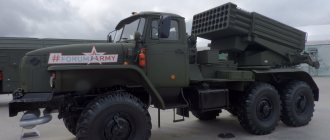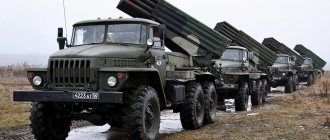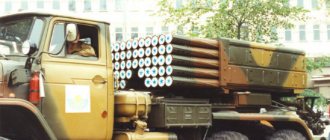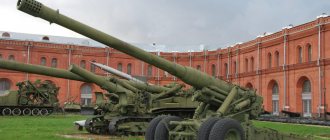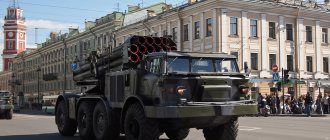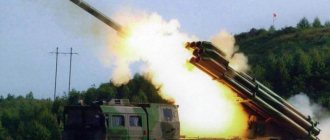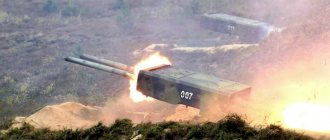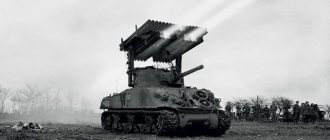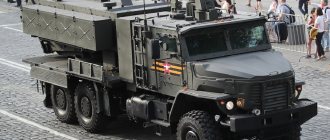Rocket artillery of the future
What awaits multiple launch rocket systems in the near future?
The past anniversary Victory Parade was a presentation of the latest Russian weapons systems. For the first time, the “Derivation” anti-aircraft systems, the TOS-2 “Tosochka” heavy flamethrower system, the “Foliage” combat mine clearing vehicle and a number of other types of weapons and military equipment were presented to the general public. Also, until recently, one of the most closed combat vehicles of the Russian Armed Forces, the Tornado-S multiple launch rocket system, drove along the paving stones of Red Square.
Development of Tornado-S began at the end of the 2000s. In 2012, the Ministry of Defense reported that the system was already being tested. In May 2019, the general director of the Tekhmash concern, Alexander Kochkin, said that by the end of the year the first brigade set of MLRS would be delivered to the troops. And already at the end of last year it became known that Tornado-S entered service with the 439th Guards Rocket Artillery Brigade in the Southern Military District.
For a long time it was believed that the Tornado-S was equipped with modular launchers. In them, the guides are combined into a single block. After a salvo, each module can easily be replaced with a new one using a transport-launch vehicle. Whereas on older Smerchs it is necessary to recharge each guide separately.
But, as the past Victory Parade showed, Tornado-S is practically indistinguishable from its predecessor. Visually, the new product differs from “Smerch” only in a small “mushroom” - a satellite navigation system receiver, as well as a “comb” of radio antennas. The latter are most likely elements of an automated control system.
Meanwhile, in the arsenal of the Armed Forces there is another “secret” multiple launch rocket system - the Uragan-1M. But for some reason the new product was not presented at the last Victory Parade. Although back in September 2016, Deputy Prime Minister Yuri Borisov said that Uragan-1M was already entering service with the troops.
Unlike the Tornado-S, the new Uragan is made of bicaliber: it can use both 220-mm rockets and heavier and longer-range 300-mm projectiles. Judging by the few photographs, the newest MLRS uses modular launchers.
Unified fire system
Until recently, the Armed Forces had a clear system for separating multiple launch rocket systems, which was inherited by the Russian Armed Forces from the Soviet Army. The 122-mm MLRS "Grad" belonged to the divisional artillery. One Grad division was part of each artillery regiment of a motorized rifle or tank division. And since 2009, rocket artillery units have become part of combined arms brigades.
All army artillery brigades had one or two divisions of 220-mm Hurricane multiple launch rocket systems. But the heavier and longer-range 300-mm Smerchs were consolidated into separate rocket artillery brigades (reabr). The ribs were part of the so-called district front set. These are units and formations that, in peacetime, are directly subordinate to the command of the military district, and during war they become the personal reserve of the front commander.
But since 2016, the system began to change. This was due to two factors. The first is the introduction of more modern multiple launch rocket systems into service. We are talking about the MLRS of the Tornado family, as well as the already mentioned Uragan-1M. The second is a rethinking of the experience of modern wars and military conflicts.
Until recently, it was believed that in modern conflicts, multiple launch rocket systems should become a kind of substitute for aviation - mainly using single high-precision guided ammunition. Thus, since the mid-2000s, the arsenals of American M270 rocket systems have been replenished with several types of “smart” missiles. Such ammunition was actively used by the US Army, the Armed Forces of Great Britain and France during the battles in Afghanistan, as well as during the occupation of Iraq.
But clashes in the Syrian Arab Republic and Donbass have shown that the main advantage of the MLRS is the ability to inflict massive fire damage over a large area in a matter of seconds. A good example of the use of MLRS is a strike on the combined tactical group of the Armed Forces of Ukraine on June 11, 2014 near Zelenopole. The Armed Forces of Ukraine then lost dozens of pieces of equipment - infantry fighting vehicles, tanks, trucks.
In Syria, massive strikes from multiple launch rocket systems destroyed fortified positions of militants of the Islamic State (IS) banned in Russia. But best of all, the volleys of Grads, Uragans and Smerchs covered the concentration areas of ISIS troops in desert areas.
Currently, the main requirement for MLRS is the ability to quickly deliver a targeted, massive strike on a target. Therefore, multiple launch rocket systems must have high-performance digital fire control systems that allow all calculations to be made, a salvo to be fired, and a target to be hit in a matter of minutes. Also, MLRS must interact with unmanned aerial vehicles and automated control systems.
Changes also needed to be made to the ammunition load of multiple launch rocket systems. New unguided rockets have been developed with increased accuracy, more complex flight trajectories, and the ability to perform simple specified maneuvers. So, in one of his interviews, the head of the Missile Forces and Artillery (RVa) of the Ground Forces, Lieutenant General Mikhail Matveevsky, said that the modern Tornado-S MLRS “has the ability to fire at eight targets simultaneously due to the dispersal of projectiles along their flight path.”
Universal "Tornado"
The development of the Tornado family of jet systems began at the end of the 2000s. Then the military department was offered two options - “G” and “C”. The first was to replace the BM-21 Grad, the second was to replace the BM-30 Smerch. The main feature of the new systems is their maximum digitalization and automation.
After receiving target designation through the automated troop control system, the Tornado on-board computer carried out all the necessary calculations. After this, the control system, using electric motors and hydraulic drives, rotated the launcher in the desired direction and gave the required elevation angle. After this, the crew commander just has to press the start button.
The Tornado-G multiple launch rocket system was the first to be ready. In 2011, a representative of the ground forces, Lieutenant Colonel Sergei Vlasov, said that the troops had already received 30 units of the latest systems. Judging by the tactical signs, the vehicles belonged to the 18th Motorized Rifle Brigade of the Southern Military District.
Currently, the Ministry of Defense is actively purchasing these systems. In particular, this year Tornado-G was added to the arsenal of the 8th separate artillery regiment and the 126th coastal defense brigade of the Black Sea Fleet. Initially, the base for the Tornado-G was only KamAZ family vehicles. But since 2016, combat vehicles have been supplied in two modifications: on the KAMAZ chassis and on the Ural chassis.
But the development of Tornado-S was delayed. In 2012, the Ministry of Defense announced that the latest system was being tested. And only last year it became known that new items began to enter the Armed Forces en masse. This year, the 232nd rocket artillery brigade of the Central Military District received the first new multiple launch rocket systems.
The identity of the Tornado-S that took part in the current Victory Parade is not entirely clear. Traditionally, the event mainly involves military equipment of units and formations of the Western Military District. It can be assumed that the newest MLRS belong to the 79th Guards Rocket Artillery Brigade. Although it is possible that the “Tornados” that passed through Red Square this year were from the training center of the Mikhailovsky Artillery Academy. The latter is located in the village of Luga, Leningrad region. It is known that it contains a large number of the latest weapons systems.
In his interview, Lieutenant General Mikhail Matveevsky called the Tornado-G and Tornado-S the pride of the Russian army. According to the commander of the missile forces and artillery, the modernized Tornado-G medium-caliber multiple launch rocket systems, as well as the Tornado-S large-caliber multiple launch rocket systems, have the ability to automatically target a combat vehicle.
“The advantages of these systems are increased power and an expanded range of missiles, improved firing accuracy characteristics, high rate of fire and increased firing range,” noted Mikhail Matveevsky.
The riddle of the Hurricane
The first photographs of the mysterious Uragan-1M appeared on social networks back in 2012. Apparently, the pictures were taken during one of the system tests. The photo showed a rocket system with two modular launchers on the MZKT-7930 Astrologer chassis.
Initially it was believed that this was the Tornado-S MLRS. But in February 2017, the Ministry of Defense published a photo gallery about the training of cadets at the Mikhailovsky Artillery Academy. In the photo captions, the new multiple launch rocket system was called “Uragan-1M.”
Almost nothing is known about the new product. In 2012, the Ministry of Defense reported that testing of the newest MLRS had already begun. And in September 2016, Yuri Borisov, the then deputy minister of defense, said that Uragan-1M was already being supplied to the troops, but so far not in sufficient quantities as we would like.” The reason for this, the deputy minister said, was problems with the contractors, the Splav holding.
Judging by the available open photographs, the Hurricane is a bicaliber system. It can fire both heavy 300mm rockets and lighter 220mm rockets. In the photograph from the Mikhailovsky Artillery Academy, the MLRS carries two modules of six guides each. Judging by the size, these are 300 mm shells. And in 2012, in one of the photographs from tests, the Hurricane carries modules, but with 15 guides each. Judging by the size, these are 220 mm rockets.
It can be assumed that the machines captured at the Mikhailovsky Academy are the first set, the supply of which Yuri Borisov spoke about earlier. Most likely, problems with the release of Hurricanes are related to its modules. For now, such products are new to the Russian military-industrial complex.
Fire and power
So, what would a modern Russian rocket artillery system look like? Brigades and artillery regiments will each have one Tornado-G MLRS division. It is noteworthy that not long ago the Ministry of Defense ordered work to modernize the fleet of old BM-21 Grad rocket systems. This was announced by Deputy General Director of the Tekhmash concern Alexander Kochkin. According to him, “not long ago the new Tornado-G MLRS system was put into service.” Today, on the basis of the scientific and technical groundwork that was obtained during the creation of this system, a project to modernize the BM-21 Grad to the Tornado-G level is already being implemented.
But in addition to the 122-mm MLRS, the artillery regiments of combined arms divisions will also be reinforced with 220-mm Uragan multiple launch rocket systems. The first reports of such rearmament appeared at the end of 2022. The new systems will radically enhance the combat capabilities of divisional artillery. And they will allow you to hit the enemy to a depth of hundreds of kilometers. The eyes of the rocket artillery will be the drones of individual UAV companies of combined arms divisions.
Army artillery brigades will also receive additional firepower. In particular, they will include the Smerch MLRS division. The first BM-30s have already entered service with the 244th separate Neman Red Banner Order of Suvorov and Kutuzov artillery brigade of the Baltic Fleet.
In addition to the Smerchs, artillery brigades will still have one or two divisions of 220-mm Uragan multiple launch rocket systems in service. But soon they will be replaced by modular bicaliber Uragan-1M. It is possible that in the near future there will be two types of army artillery brigades. Some are fully armed with Uragan-1M MLRS, while others are equipped with conventional Hurricanes and Smerchs. And the placement and specific armament of the brigades will be determined by their location. So, most likely, the artillerymen of the 1st Guards Tank Army will be the first to master the Uragan-1M.
“District front-line” rocket artillery brigades will be gradually re-equipped from the BM-30 “Smerch” to the more modern “Tornado-S”. At the same time, the task of the brigades will change. Previously, these formations delivered a massive strike with the forces of a division or the entire brigade. But now the MLRS will be as decentralized as possible and will operate as independent units of two or three systems.
The combat use of Smerchs showed that even one vehicle can radically influence the situation on the battlefield. Thus, on February 10, 2015, an airfield in the city of Kramatorsk was attacked (which was under the control of Ukrainian armed forces). As a result, 17 people died. Neither the Donetsk self-proclaimed republic nor the Ukrainian Armed Forces took responsibility for the shelling.
The more modern Tornado-S has much higher accuracy. As Lieutenant General Mikhail Matveevsky noted in his interview, now each such MLRS can simultaneously hit up to eight targets.
In the near future, the Russian Armed Forces will receive a flexible and universal tool - a new system for using multiple launch rocket systems. The commander will be able to bring down tons of fire on the enemy in a matter of minutes and with extreme precision.
Pavel Ivanov
Pavel Dmitrievich Ivanov is a military journalist.
Prerequisites for creation
The main difference between cannon and rocket artillery is the design of the propellant and the method of projectile acceleration.
In barrel artillery, the throwing device is structurally relatively complex (see article “Cannon.”). The projectile is accelerated in the barrel by gases formed as a result of the explosive combustion of the projectile, and, having flown out of the gun barrel, then flies by inertia. In this case, the propellant charge is structurally very simple and may or may not be (unitary projectile) (separately loaded projectile) a structural part of the projectile.
In rocket artillery, the throwing device is relatively simple, and the projectile is always unitary and is accelerated in flight by its own rocket engine in flight and after exiting the guide. (The actual fuel charge of the rocket’s propulsion system corresponds to the propellant charge of a cannon artillery projectile.)
The possibility of repeated use of both the barrel itself and the sighting equipment has long played a decisive role in the choice of projectile/missile. Artillery shells are much simpler and cheaper than rockets to produce and operate, so firing a cannon is cheaper than launching a rocket.
However, barrel artillery differs in that the projectile accelerates only when it is in the barrel. This creates many problems: large overloads when firing, high barrel velocities, huge dynamic loads on the throwing device.
Loads on the throwing device force the creation of thicker and heavier barrels. And this, in turn, increases the mass and dimensions of the guidance system, the bolt part and the gun as a whole. The projectile also experiences high loads during acceleration in the gun barrel, which reduces the share of the charge in the total mass of the projectile.
High barrel velocities also negatively affect the firing range - the projectile has to overcome excess aerodynamic drag at the initial stage of flight. (In airless space this is of course not significant, but not a single modern cannon artillery piece is capable of operating in airless space.)
Large overloads during firing create a problem for cannon artillery. In the middle of the 20th century, guided weapons began to appear, which fundamentally increased the effectiveness of warfare. But the mechanisms of the guidance systems could not withstand the overload when fired - the designers needed a more gentle system for delivering ammunition to the target.
On the other hand, when firing a rocket projectile - rocket launches - there is no muzzle recoil. As a result, the launcher guide is structurally very simple and, as a result, cheap to manufacture and compact. This also allows you to make multi-charge launchers, which, coupled with the absence of muzzle recoil, makes it possible to implement salvo fire as the most effective method of area shelling of the enemy.
"Made of wood and rags"
In the early 30s, airplanes were literally built “from wood and rags,” but then the situation began to change.
Aluminum and steel were increasingly used, and soon the question arose about changing the means of destroying such aircraft by fighters. In addition, the Douai doctrine reigned in the minds of the aviators, and everyone was preoccupied with fighting the hordes of heavy bombers - durable and bristling with many machine guns. On the same topic
The war could have been different: unknown aircraft designed by Polikarpov
There were several ways to solve the problem of defeating such aircraft.
Firstly, increase the number of machine guns and their rate of fire. However, from the very beginning it was clear that these were half measures. Secondly, it was possible to increase the caliber of the weapon by creating an automatic cannon. This turned out to be the most promising solution for that time - but also the most difficult.
The third option is to come up with something different, stirring up some kind of “wunderwaffel”.
How it all began
In 1938, employees of Research Institute No. 3, in parallel with the implementation of work on object No. 138 - a gun for firing 132-mm chemical shells (ordered by the Artillery Directorate), “... designed and passed factory tests and... prepared for extensive range testing (at the AU range) rocket a mechanized installation designed to provide a chemical attack with 132 mm chemical missiles (SOV and NOV) with a capacity of 7 liters. The installation allows you to fire across areas with both single shots and a salvo of 2, 3, 6, 12 and 24 shots. The installations, combined into batteries of 4–6 vehicles, are a very mobile and powerful means of chemical attack at a distance of up to 7 kilometers...” (according to data from October 20, 1938). “Two mechanized multiple rocket launchers were manufactured, mounted on ZIS-5 vehicles with an ammunition load of 24 rounds, which passed factory firing tests at the Sofrinsky artillery range and partial field tests at the Red Army TsVKhP with positive results.” Another testing site was the PZHP. Thanks to this, “a path has been outlined for the widespread and effective use of rocket projectiles in ground conditions.” The installation and a 132-mm rocket chemical projectile containing 7 liters of toxic substance successfully passed field and state tests and were planned for delivery into service in 1939. The purpose of a mechanized vehicle installation is a surprise attack by firing chemical, high-explosive fragmentation, incendiary, illuminating and other missile shells. The first option is without a guidance device, the second - with a control device.
The initiator of the idea of “a mechanized installation for a chemical attack, which at the same time opens up the possibility in this regard of the use of missile shells in the ground forces of the Red Army” (letter from the director of Research Institute No. 3 B. M. Slonimer dated 05.25.39) was named the chief engineer of the institute, Andrei Grigorievich Kostikov. The design and testing of modifications of the mechanized installation was carried out by a team of employees of Research Institute No. 3 under the leadership of I. I. Gvai. A more significant contribution to the work of designers V.N. Galkovsky (from April 1939), A.P. Pavlenko and A.S. Popov.
